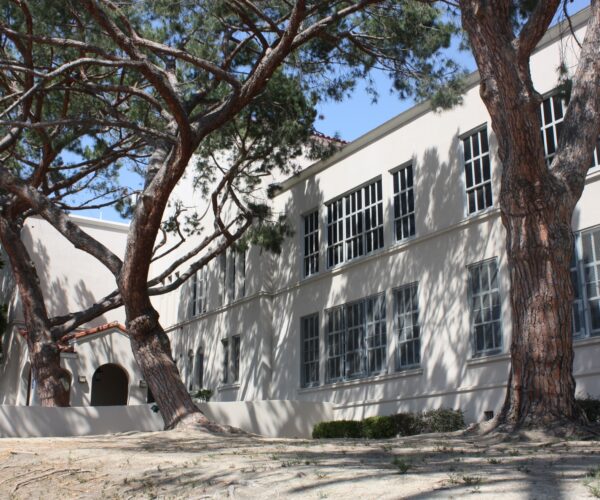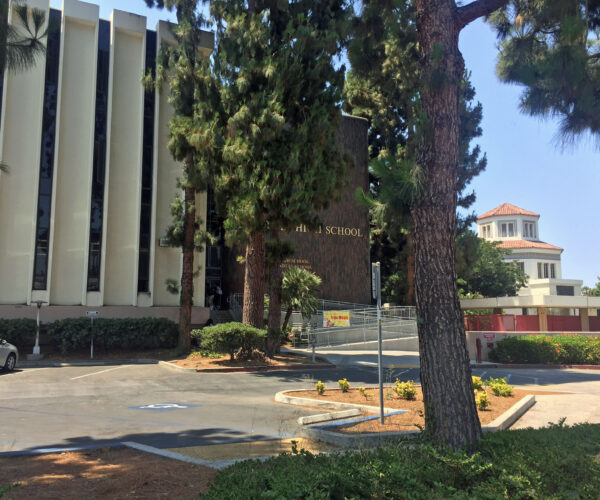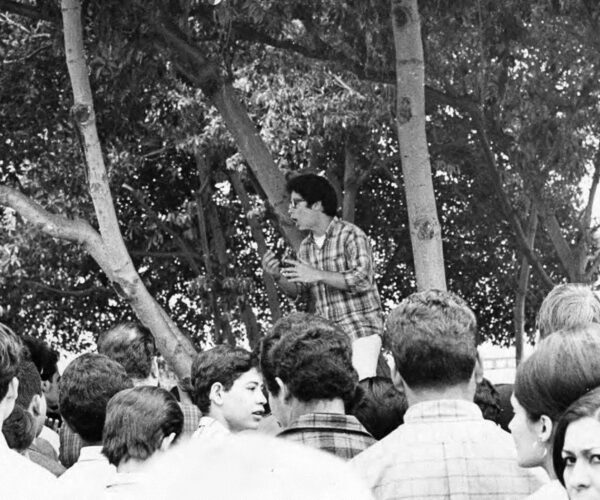
Place
Leuzinger High School
Lost
Historic places that have been demolished or irreparably altered.


Place Details
Address
Year
Style
Designation

Leuzinger High School | Adrian Scott Fine / Los Angeles Conservancy
Overview
Spurred by the passage of two bond measures, the Centinela Valley Union High School District launched a series of construction projects at Leuzinger High School in the City of Lawndale. The projects moved forward without any environmental review or evaluation of potential historic resources on the historic campus.
While not every older school campus is historic, the Conservancy does believe that Leuzinger High School campus is significant and should be properly evaluated. The campus contains a number of irreplaceable buildings that tell the story of both the school’s and Lawndale’s growth and development.
The Daily Breeze reported in October 2010 that “about three-quarters of Leuzinger High would be torn down and rebuilt” and the school district maintained an aggressive demolition and construction schedule.
In August 2010, the district demolished the school’s Industrial Arts Building (1930) and in July and August of 2011 demolished all seven single-story “finger” classroom buildings (1948-56). Referred to as finger buildings for their long, slender shape and often arranged in rows with courtyard space in between, these buildings at Leuzinger High typified postwar California schools and featured such green design elements as passive solar shading.
In May, June, and August of 2011, Conservancy staff attended board meetings of the school district and strongly urged the school board to prepare an environmental impact report (EIR) as part of its ongoing project. We emphasized that the campus can certainly accommodate expansion and upgrades, which an EIR does not prevent. State law (the California Environmental Quality Act, or CEQA) requires an EIR to outline impacts to historic resources and evaluate alternatives to mitigate those impacts.
Despite protest from local residents and Leuzinger High School alumni, the Centinela Valley Union High School District school board voted at their July 26, 2011 board meeting to adopt a Notice of Exemption from environmental review for the Leuzinger High School campus project.
In May 2012, the local advocacy coalition Friends and Alumni of Leuzinger High School reached a settlement with the Centinela Valley Union High School District following the advocacy group’s lawsuit to protect historic buildings on the Lawndale campus.
The District agreed to designate the primary buildings on campus as historic resources and rehabilitate them following preservation guidelines. These include the Main Building, Girl’s Gym and Dance Studio, Thompson Gym, and Library. Although the Cafeteria will be demolished as part of the settlement, the New Deal-era murals originally housed in that building will be relocated to the Main Building.
About This Place
About This Place
Located on Rosecrans Avenue near Hawthorne Boulevard in the South Bay city of Lawndale, Leuzinger High School opened in 1931 in what was then a largely agricultural setting. It is the oldest of the three high schools in the Centinela Valley Union High School District.
The school acquired a distinctive identity soon after opening: in return for providing staging facilities for aspects of the 1932 Summer Olympics held in Los Angeles, the school was authorized to use the Olympic rings and motto as its emblem.
In addition to Leuzinger High School’s cultural association with the Olympics, several of the buildings on campus are architecturally distinct and represent different periods of growth in the school’s development through the postwar era.
Some of the buildings on campus were designed by noted Southern California architect T. C. Kistner, who for a time served as the official architect for the San Diego School Board. These include the Main Building (1930, later remodeled) and a PWA Moderne girls’ gymnasium (1937) that was financed in part through a Public Works Administration grant.
Postwar prosperity brought significant expansion to the Leuzinger High School campus with the construction of several new buildings and a modernization of the school’s Main Building (1955). New construction included the boys’ gymnasium (1957), which features exposed, structural arches, and the distinctive finger buildings (1948-56) that were demolished in 2011.
Our Position
The Conservancy strongly believed that the campus of Leuzinger High School was a historical resource and should have been treated as such under CEQA. The following points summarize the Conservancy’s advocacy position:
- The Leuzinger High School campus was potentially eligible for listing in the California Register as a historic district, and it should have evaluated as part of the public environmental review process under CEQA.
- Before the Centinela Valley Union High School District continued with the multi-phased master plan for updating the Leuzinger High School campus, they should have prepared an environmental impact report (EIR) to assess the historic resources on campus and how upgrades can take place with minimal impacts to those historic resources.
- An EIR does not prevent expansion and upgrades at Leuzinger High School. It merely outlines impacts to historic resources and evaluates alternatives, including preservation-based approaches, as a way to mitigate those impacts.
- By reusing and reinvesting in its existing buildings, Leuzinger, like many other historic schools, can be adapted to provide high-performing educational facilities while respecting its rich history.
Community-Centered Schools:
As important anchors and centers of community, older and historic schools help define the places in which we live and are key to the health and sustainability of a neighborhood. Throughout the country, historic schools have been successfully adapted and upgraded to meet current educational standards while maintaining their authentic character. To find out more, visit the National Trust for Historic Preservation.






